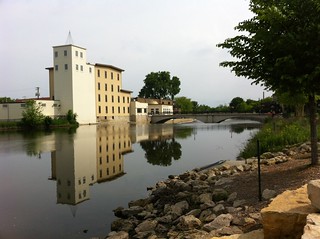We’re number 2! Northfield ranked second on Livability.com’s Top 10 list of Most Livable Small Cities (the top spot went to Los Alamos, NM). It’s fun to win something unexpectedly and gratifying to have an unexpected voice tell the world what a great town Northfield is. Add the additional media coverage around the region spawned by the ranking and Northfield is feeling pretty happy with itself.
But streets.mn readers shouldn’t be surprised by Livability.com’s recognition since you could read a post about Northfield more than a year ago noting many of the same assets Livability.com considered significant in its ranking like Northfield’s colleges, industry, scenic Cannon River, events, historic main street, and proximity to the Twin Cities. Streets.mn readers also advocated for Northfield when Stillwater won streets.mn’s 2012 poll noting that Northfield was more than “visitable,” but livable.
Livability.com’s 2014 ranking criteria (2013’s criteria are here) seem almost tailor-made for Northfield: amenities like farmers markets, parks, weather, and the role of arts in the community as well as proximity to healthcare (Northfield is about equidistant from Twin Cities’s medical resources and Rochester’s Destination Medical Center), good schools, community involvement, river, downtown, etc. are valued for attracting businesses, investment, residents, and visitors all of which put dollars into the local economy.
From “growth” to “place”
The Livability.com’s Top 10 list is particularly satisfying because it emphasizes how the conversation has changed in the last decade or so and how this benefits a place like Northfield. When I joined the Northfield Planning Commission in 2001, the loudest voices shouted about “growth.” Northfield’s new Target store, additional development along MN 3, suburban-style residential development, the new hospital in the cornfields, the new middle school in the other cornfields, and planning for more edge development were the priorities. Thoughtful voices questioning the impact (economic or environmental) of the low density, high infrastructure development pattern were dismissed as anti-business, anti-development, college liberals who didn’t understand economics.
Since then, the public conversation has been shifting from “growth” to “place.” More than that, the shift can be characterized as moving from seeking generic growth to valuing particular places. “Place” has even been described recently as the new American dream. Northfield with its historic downtown, colleges, and rural edges is particularly rich in distinctive “Northfieldishness” so we should be able to dream big with the increasing recognition that “place” is not just pleasant, but economically valuable in multiple ways. Livability.com’s ranking reflects the interdependence of distinctive attributes and economic value:
- Downtowns like Northfield’s, with multi-story, mixed use, zero-lot line development pattern use land and infrastructure efficiently and pack more value on less land as well as being visually distinctive. Distinctive downtowns are desirable, too, and Northfield is held up as a role model.
- Carleton and St. Olaf, criticized as non-property tax paying entities in the “growth” conversation, are recognized as huge contributors to Northfield as a place. Colleges are large, stable, high quality employers; provide cultural offerings which help Northfield punch way above its weight, add a much more diverse mix of voices to the community conversation, bring thousands of people to town as students, parents, and visitors and sends them out as alumni who may return with their families or businesses.
- Natural advantages like Northfield’s rural edge Cannon River, Carleton’s Arb and St. Olaf’s natural lands (colleges, again!) are taken for granted under the “growth” scenario or considered as ripe for development, but are valuable to attract visitors and sustain residents, contribute to the environmental and physical health of Northfield (and its connected watersheds and wildlife corridors). Businesses build on these assets, too, from kayak rental to our own pizza barn. The Mill Towns Trail has been working to connect Northfield to both the Sakatah Singing Hills Trail and the Cannon Valley Trail to ride from Mankato to Red Wing.
- Events both huge (like the Defeat of Jesse James Days – come to Northfield September 5-7) and smaller (but more frequent Riverwalk Market Fair each weekend) bring community members together, streets.mn readers to Northfield, and pump dollars into the local economy.
Why rankings matter
Northfield seems to have it all, but small cities like Northfield need the kind of recognition and reward the Livability.com ranking provides and provides without the placemaking jargon, too. Northfield has its place-rich center and colleges, but still has lots of room to sprawl (as well as the usual regulatory and financial incentives to encourage this development pattern). Close to downtown, WalkScores are near perfect (my address scores 98), but the edges of town are car-dependent. Interest in connections newer, low-density development to schools and downtown with sidewalks, bike friendly streets, and trails costs money and often faces citizen opposition. Economic development conversations reveal tension between the “growth” mentality and the lower cost, place-based, locally grown initiatives. Northfield is a wonderfully livable place, but sometimes struggles to build on its success.
Media recognition of the value of being Northfield and not Faribault, Lakeville, St. Paul or even Stillwater helps build the critical mass needed to support policy and decision-making which reinforce the distinctiveness of the city and gives a vote of confidence for continuing to advocate for public investment in Northfield’s low cost, high performing assets.
